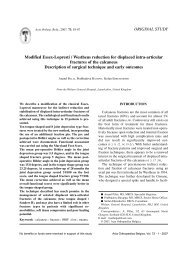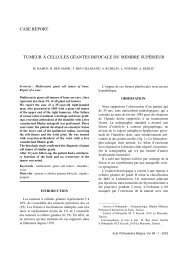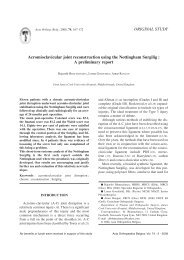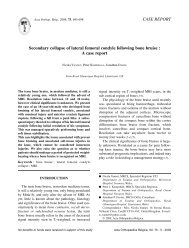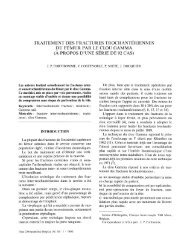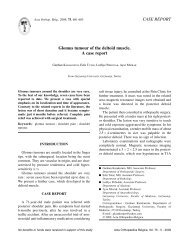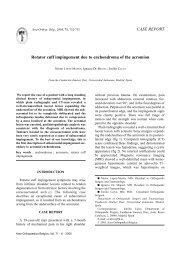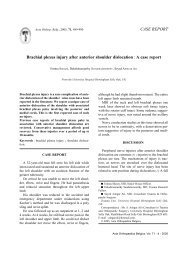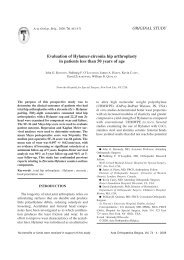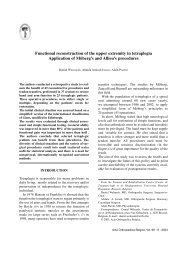Epiphysiodesis of the greater trochanter in Legg-Calvé-Perthes ...
Epiphysiodesis of the greater trochanter in Legg-Calvé-Perthes ...
Epiphysiodesis of the greater trochanter in Legg-Calvé-Perthes ...
- No tags were found...
You also want an ePaper? Increase the reach of your titles
YUMPU automatically turns print PDFs into web optimized ePapers that Google loves.
310 A. VAN TONGEL, G. FABRYFig. 2. — The NSA (neck-shaft angle) on <strong>the</strong> AP radiograph(8).Fig. 1. — The ATD (articulo-<strong>trochanter</strong>ic distance) is measuredas <strong>the</strong> distance <strong>in</strong> millimeters between two parallel l<strong>in</strong>esperpendicular to <strong>the</strong> axis <strong>of</strong> <strong>the</strong> shaft <strong>of</strong> <strong>the</strong> femur, one at <strong>the</strong>level <strong>of</strong> <strong>the</strong> tip <strong>of</strong> <strong>the</strong> <strong>greater</strong> <strong>trochanter</strong> and <strong>the</strong> o<strong>the</strong>r at <strong>the</strong>highest part <strong>of</strong> <strong>the</strong> ossified femoral head. The distance isrecorded as positive if <strong>the</strong> tip <strong>of</strong> <strong>the</strong> <strong>greater</strong> <strong>trochanter</strong> is caudalto <strong>the</strong> highest part <strong>of</strong> <strong>the</strong> femoral head and negative if <strong>the</strong>tip <strong>of</strong> <strong>the</strong> <strong>trochanter</strong> is proximal to <strong>the</strong> femoral head (8).The medical and radiological records from more thanone year before <strong>the</strong> operation were available <strong>in</strong>26 patients. Five patients were seen only one monthbefore operation. All 31 patients (32 hips) had postoperativecl<strong>in</strong>ical and radiological follow-up. There were7 girls and 24 boys. The left hip was affected <strong>in</strong>23 patients, <strong>the</strong> right hip <strong>in</strong> 7 patients and <strong>in</strong> one patientboth hips were <strong>in</strong>volved.The mean age at operation was 10 years and6 months, rang<strong>in</strong>g from 7 years and 11 months to12 years and 1 month. The mean follow-up time was4 years and 2 months (range : 7 months to 7 years and9 months).Indications for epiphyseodesis were a positiveTrendelenburg sign with overgrowth <strong>of</strong> <strong>the</strong> <strong>greater</strong><strong>trochanter</strong> or an <strong>in</strong>crease <strong>in</strong> relative overgrowth dur<strong>in</strong>gfollow-up.In 24 cases, a shelf acetabuloplasty was performed at<strong>the</strong> same time. In 5 cases, only an epiphyseodesis <strong>of</strong> <strong>the</strong><strong>greater</strong> <strong>trochanter</strong> was done, and on two occasions <strong>the</strong>epiphyseodesis was done a few months after a shelfacetabuloplasty.The Phemister technique for epiphyseodesis asdescribed by Langenskiöld and Salenius (12) wasused (21).The growth <strong>of</strong> <strong>the</strong> <strong>greater</strong> <strong>trochanter</strong> was evaluated,us<strong>in</strong>g <strong>the</strong> articulo-<strong>trochanter</strong>ic distance (ATD) (fig 1).The neck-shaft angle (NSA) was also measured (fig 2).Both measurements were done pre- and postoperatively,both on <strong>the</strong> affected hip and <strong>the</strong> normal hip (8, 17). Thecl<strong>in</strong>ical Trendelenburg sign was evaluated (2, 6) and comparedwith <strong>the</strong> ATD and <strong>the</strong> NSA <strong>of</strong> <strong>the</strong> <strong>in</strong>volved hip.The results were analysed us<strong>in</strong>g statistical analysiss<strong>of</strong>tware (SAS) (18). The age dependence <strong>of</strong> <strong>the</strong> ATD andNSA and <strong>the</strong> difference between boys en girls andbetween different procedures were analysed us<strong>in</strong>gregression analysis. The differences between pre-andpostoperative observations were evaluated by analysis <strong>of</strong>covariance. The evaluation <strong>of</strong> <strong>the</strong> cl<strong>in</strong>ical situation wascalculated with <strong>the</strong> SIGN testRESULTSFirst <strong>the</strong> NSA and ATD <strong>of</strong> <strong>the</strong> normal hip wereevaluated. The average distance and angle for everypatient dur<strong>in</strong>g one year (for example from <strong>the</strong> 7 th to<strong>the</strong> 8 th birthday) were calculated. Regression analysisproduced curves, show<strong>in</strong>g <strong>the</strong> evolution <strong>of</strong>ATD and NSA <strong>in</strong> <strong>the</strong> normal hips accord<strong>in</strong>g to ageActa Orthopædica Belgica, Vol. 72 - 3 - 2006



